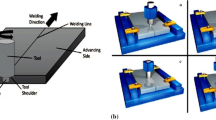Abstract
A novel slip factor accounted for thermal model is being used to predict the temperature with time and the effect of welding and rotations on heat input for weld length peak-temperature of the friction stir welding process. Material used in this study is aluminium alloy of AA6061 grade which is used in aerospace applications. For various rotations and weld velocities, friction stir welding experiments were conducted on aluminium alloy plates. The plates were fixed with thermocouples at different locations from weld centerline to measure the temperatures during the welding process. The temperature with time and locations predicted by the model along the transverse direction are closely matching with the experimental results. The heat input for unit length of weld and peak-temperature increases as rotation increases and decreases as weld velocity increases. The energy required for welding for length is minimum at the combination of lower rotation and higher weld velocity in the defect-free zone.
Access this chapter
Tax calculation will be finalised at checkout
Purchases are for personal use only
Similar content being viewed by others
References
Rajamanickam N, Balusamy V, Reddy GM, Natarajan K (2009) Effect of process parameters on thermal history and mechanical properties of friction stir welds. Mater Des 30:2726–2731
Riahi M, Nazari H (2010) Analysis of transient temperature and residual thermal stresses in FS welding of aluminum alloy 6061-T6 via numerical simulation. Int J Adv Manuf Technol 55:143–152
Song M, Kovacevic R (2003) Thermal modeling of FS welding in a moving coordinate system and its validation. Int J Mach Tools Manuf 43:605–615
Woo W, Choo H, Withers PJ, Feng Z (2009) Prediction of hardness minimum locations during natural aging in an aluminum alloy 6061-T6 friction stir weld. J Mater Sci 44:6302–6309
Chao YJ, Tang W (2003) Heat transfer in FS welding—experimental and numerical studies. Trans ASME 125:138–145
Prasanna P, Rao BS, Mohana Rao GK (2010) Finite element modeling for maximum temperature in FS welding and its validation. Int J Adv Manuf Technol 51:925–933
Nandan R, Roy GG, Lienert TJ, Debroy T (2007) Three-dimensional heat and material flow during FS welding of mild steel. Acta Mater 55:883–895
Hamilton C, Dymek S, Sommers A (2008) A thermal model of FS welding in aluminum alloys. Int J Mach Tools Manuf 48:1120–1130
Hamilton C, Sommers A, Dymek S (2009) A thermal model of FS welding applied to Sc-modified Al–Zn–Mg–Cu alloy extrusions. Int J Mach Tools Manuf 49:230–238
Emam SA, Domiaty AE (2009) A refined energy-based model for friction-stir welding. World Acad Sci Eng Technol 53:1016–1022
Selvaraj M, Murali V, Rao SK (2013) Thermal model for FS welding of mild steel. Multidiscip Model Mater Struct 9:49–61
Selvaraj M (2014) A temperature dependent slip factor based thermal model for FS welding of stainless steel. Sadhana-Acad Proc Eng Sci 38:1393–1405
Soundararajan V, Zekovic S, Kovacevic R (2005) Thermomechanical model with adaptive boundary conditions for FS welding of Al 6061. Int J Mach Tools Manuf 45:1577–1587
Dickerson T, Shi Q, Shercliff, HR (2003) Heat flow into FS welding tools. In: 4th international symposium on FS welding, Park City Utah, USA
Chen Z, Pasang T, Qi Y (2008) Shear flow and formation of Nugget zone during FS welding of aluminium alloy 5083-O. Mater Sci Eng, A 474:312–316
Author information
Authors and Affiliations
Corresponding author
Editor information
Editors and Affiliations
Rights and permissions
Copyright information
© 2021 Springer Nature Singapore Pte Ltd.
About this paper
Cite this paper
Selvaraj, M. (2021). Optimizing the Parameters for Friction Stir Welding of an Aluminium Alloy. In: Vijayan, S., Subramanian, N., Sankaranarayanasamy, K. (eds) Trends in Manufacturing and Engineering Management. Lecture Notes in Mechanical Engineering. Springer, Singapore. https://doi.org/10.1007/978-981-15-4745-4_65
Download citation
DOI: https://doi.org/10.1007/978-981-15-4745-4_65
Published:
Publisher Name: Springer, Singapore
Print ISBN: 978-981-15-4744-7
Online ISBN: 978-981-15-4745-4
eBook Packages: EngineeringEngineering (R0)




